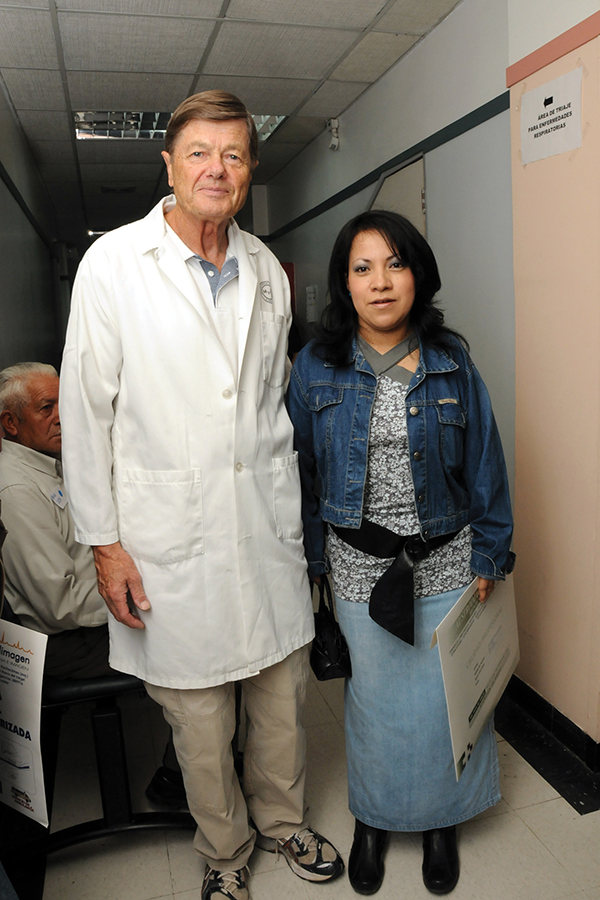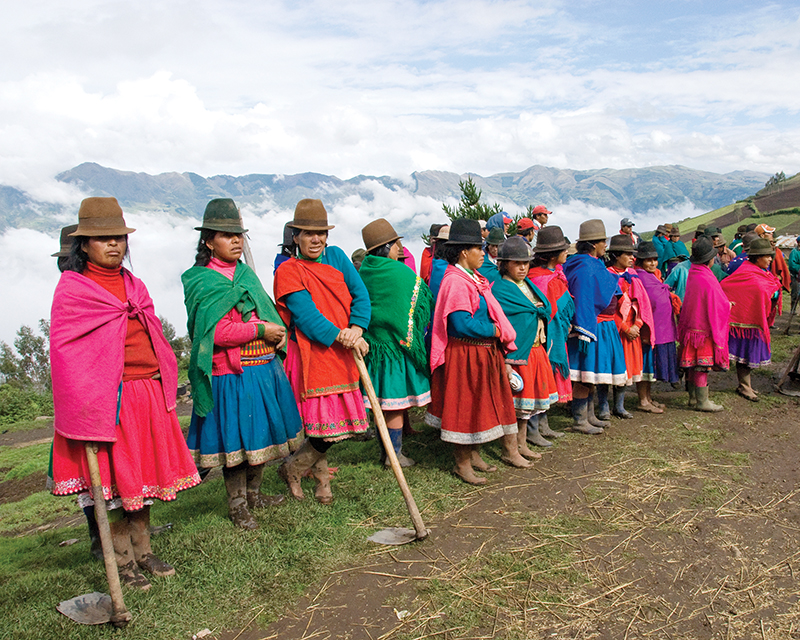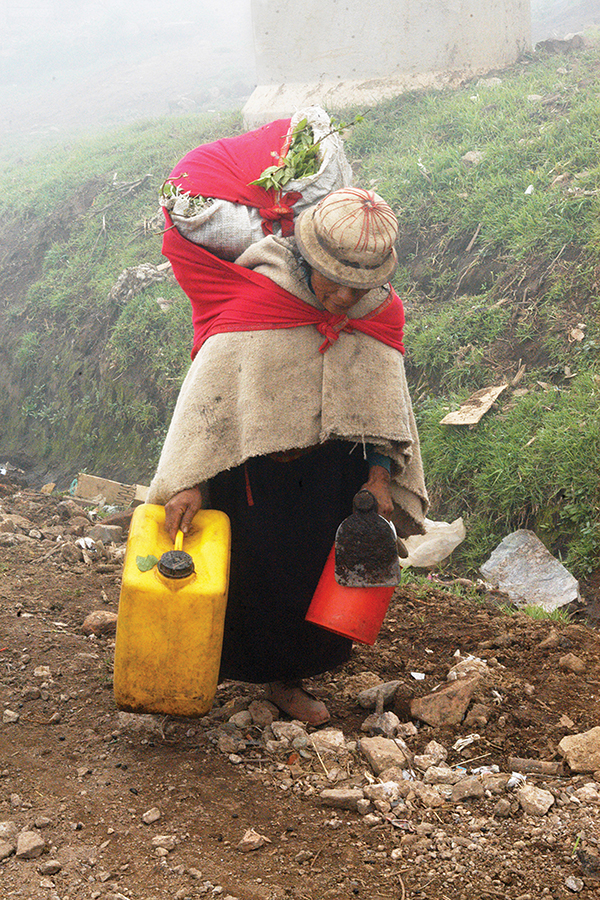
It’s Friday evening and the Tomebamba Cuenca Rotary Club in Cuenca, Ecuador, has invited us for a fireworks show, a pig roast and an evening of musical entertainment – their way of saying, “Thank you for helping our people.” Our 10-day humanitarian mission to Ecuador has almost come to an end. Many of our medical supplies have already been repacked into hockey bags.
There’s to be a special guest performer tonight; we’re curious and full of anticipation. In previous years, we’ve enjoyed traditional Ecuadorean dancers, pan-flute trios, marimba bands and guitar solos. Who will it be tonight?
A single guitar begins playing a mellow tune and a young woman in an elegant, full-length dress strolls towards the dance floor with a microphone in hand. The woman, Miriam, smiles and starts singing. We are mesmerized and remain silent. But when the merengue band starts in and Miriam swivels her hips, turning full circle to the beat of the music, we are brought to our feet, clapping delightedly. Many are moved to tears. This is a momentous and significant moment, both for Miriam and for us.
When Miriam first came to the medical clinic, she was a 29-year-old with a big dream. She could hardly move. Suffering from severe, untreated rheumatoid arthritis, she had not walked for four years and needed to be lifted up onto the examining table by her brother. “I want to walk again,” she said. “I want to study again. I want to dance again – to salsa.”
The surgeons decided that the best approach was to perform a series of surgeries over a two-year period. During the first operation, Miriam’s right hip and knee were replaced. The following year, her left hip and knee were replaced. The journey through surgery after surgery and rehabilitation was not easy, but Miriam never wavered in her hope to walk and dance again. Now, here she is, standing, walking, singing and swaying those hips at the Tomebamba Cuenca Rotary party. Not only can Miriam dance, she also works full-time as a secretary and is able to support herself and her extended family. In gratitude, Miriam returns every year to work as a translator for Operation Esperanza, the team that helped make her dream come true. Operation Esperanza (Operation Hope), as the mission is called, provides free hip and knee-replacement surgeries to poor Ecuadorians: It treats adults as well as offering surgeries for children with dislocated hips and club feet. The team leader is orthopaedic surgeon, Dr. Thomas Greidanus, who began the mission to Cuenca 17 years ago and has been on staff at the Royal Alexandra Hospital since 1992. Earlier this year, 16 staff from the Royal Alexandra Hospital – 12 nurses, two physiotherapists, one surgical assistant and the hospital’s medical photographer – travelled with him to Cuenca, swapping vacation time to work 12-hour shifts abroad. Complementing them were doctors and nurses from the Misericordia and Leduc hospitals, as well as from hospitals in Calgary and Vancouver. As the wife of the team leader and a former nurse, I, too, was a part of Operation Esperanza.

Cuenca is a city of 350,000 and lies approximately 435 kilometres south of Quito in the highlands of the Andes Mountains. Its mild weather, narrow cobblestone streets, picturesque flower markets and grand domed cathedrals attract many North American retirees. This vibrant colonial city, with its modern hospitals, however, belies the fact that a very large number of Ecuadorians live in poverty with no access to healthcare or even clean drinking water. Poverty is most prevalent in rural areas and greater among the many indigenous people.
Most of the patients travel a long way to the clinic in Cuenca, often coming from mountain villages as high as 3,500 metres or more,or from towns as far as a 14-hour drive away. Getting to the hospital is a major feat in itself when one can’t walk or afford transportation. The line-up begins in the morning even though the clinic doesn’t open until the afternoon. Eventually the line snakes from the clinic entrance, up the ambulance ramp, and down the block. For every patient, there are at least a half dozen accompanying family members, including many children. Arriving at the screening clinic early in the heat of the afternoon with the rest of the team, I wonder how we will ever see them all before midnight.
Many are indigenous Ecuadoreans wearing traditional clothes – women wearing short, colourful pleated skirts, lace blouses and Panama hats, and men with ponchos, felt hats and rubber boots. It’s an interesting and colourful gathering. The ones who have been referred here are the poorest of the poor for whom medicine and surgery is either unavailable or unaffordable. Here, the patients, like Miriam, hope their prayers will be answered – a new hip or knee, corrective surgery for a club foot, medicine allowing relief from pain, deformity and immobility. Many Royal Alexandra Hospital staff members have gone to Ecuador with Operation Esperanza for as many as 10 consecutive years – well before the words “voluntourism” and “service travel” became popular. To increase their chances for getting the time off, they submit their vacation requests a year ahead of time. Countless hours are spent prior to departure – fund-raising, planning, gathering and packing a huge amount of supplies, including hip and knee prostheses, medication, crutches, walkers and many stuffed animals. When it’s time to go, several hospital staff leave young children behind, relying on the support of family members to make their participation on the mission possible.

“It is Miriam who reminds me of why we do this work,” says operating room nurse, Lisa Watson, who has gone to Cuenca annually for 10 years. “As much as the patients are blessed, I am blessed even more – by the love of the patients and the fulfillment of seeing them after [surgery] .”
For nurse Cari Noelck, in charge of the operating rooms in Cuenca, the most recent trip marks her 10th year with the team, having taken two years off after giving birth to her youngest daughter. “I probably average about 20 to 30 hours per month year-round organizing, buying and packing supplies and instruments,” she says. “It’s a lot of work, but it’s re-energizing. I always come back with a new appreciation for my life and all that we have in Canada.”
Working with Operation Esperanza this year was a new experience for nurse Susan Mann. “I am overwhelmed,” she says. “What we do here without state of the art equipment is phenomenal … When I get back home, I’ll dig down inside me and always remember this.” The experience also has Mann reflecting about her life in Alberta. “We are surrounded by plenty. We are so blessed. We need to use some of this to give back to those in need.”
For “Dr. Tom,” as they call him in Ecuador, volunteering his time and skills in Cuenca, “brings me peace, happiness, and the satisfaction of knowing I have made a dramatic difference in the lives of these poor people.”
A local physician, Dr. Manuel Avila, travels to the patients’ homes to provide follow-up care after the team leaves. Poor himself because he devotes his medical practice to helping the needy, Avila used to make these home visits by bus and burro until a volunteer group of construction workers from the U.S. raised funds to buy him a car. Despite their poverty, the patients find ways to show their gratitude. One family provided Avila with an enormous breakfast of guinea pig, chicken, potatoes and fresh milk. At the end of that day, he set out for home with a 50-pound bag of potatoes, bags of queso (cheese), two guinea pigs, and two live chickens in the back seat of his car.
Like Miriam’s, the lives of many Ecuadoreans have been dramatically changed over the years because a group of skilled healthcare providers was willing to sacrifice some vacation time to go abroad to serve others in dire need. In doing so, their lives, too, have been changed.
Plans for next year’s mission, from January 30 to February 10, 2014, are already underway.
The next fundraiser for Operation Esperanza (dinner, silent auction and live auction with Danny Hooper) will be held October 4, 2013, at the Santa Maria Goretti Centre.
One woman’s journey to conceive a child has now led an Edmonton woman on her own voyage – one that will take her to a remote part of Nepal. Allissa Keane decided to volunteer for the not-for-profit organization, Acupuncture Relief Project (ARP), after reading a story on its website about a patient who travelled weekly to an ARP clinic for fertility treatments until she was finally able to conceive. “My heart was on a plane to Nepal after I read that story,” says Keane.
Keane, an acupuncturist, trained doula and certified yoga instructor, will leave her own patients behind and take her skills to Kogate, Nepal for seven weeks. ARP has worked out of clinics in Nepal for six years and the organization is building a new clinic in Kogate this fall. It will be the only place offering primary health care to the surrounding area, which has about 30,000 residents. “Acupuncturists are uniquely qualified to provide health care in these areas partly because acupuncture is inexpensive. They can also provide diagnosis and access to care,” says Andrew Schlabach, president of ARP.
Along with a group of five other natural-health practitioners, Keane will treat 10 to 15 people a day in makeshift examination areas – a large number compared to the 15 to 25 people she treats a week at her regular office in the Strathcona Health Centre.
Kogate is four hours away from Kathmandu, the capital of Nepal and its largest urban centre, with just over one million residents. But the living conditions in Kogate will be quite different than Kathmandu, let alone Canada – the village has electricity, but no phone access, says Keane. -Sydnee Bryant







